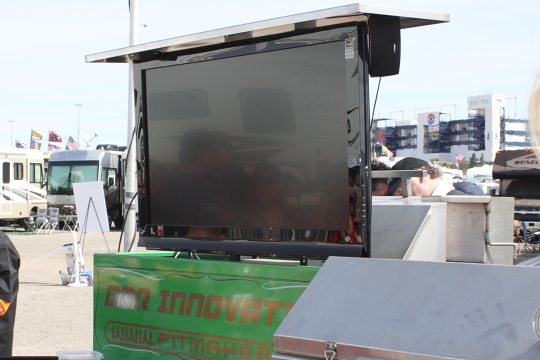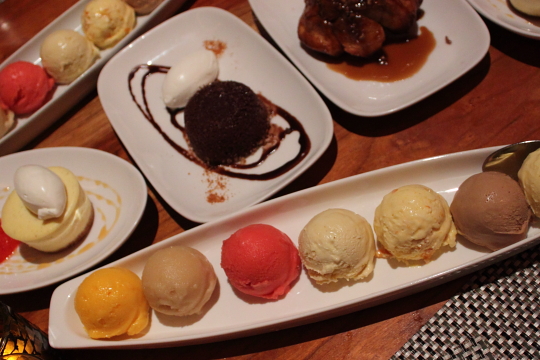Last weekend, Michele and I were invited to participate in the 2011 Kingsford University, a NASCAR-themed barbecue and grilling event, held in everyone's favorite adult cartoon of a city, Las Vegas, Nevada. What follows is a photo recap of the trip's highlights. I don't do multipart event posts, so this is a little long, but I promise it will be a quick read. Enjoy!
The first night featured a welcome dinner at Tom Colicchio's Craftsteak. The festivities began with a cocktail hour where we got to meet and greet our fellow attendees. While saddened more former classmates from the fabulous Healdsburg event in 2009 weren't there, we were thrilled a few were, including good pals (and a couple of my favorite food bloggers), Brooke from Food Woolf (right) and Tamar from Starving Off the Land. While the steak tartare appetizer was a special treat, it couldn't compare to catching up with these two!
I'm a huge fan of Top Chef, which means I'm a huge Tom Colicchio fan, but I'd never had the opportunity to dine at one of his restaurants. It was worth the wait. We enjoyed a great steak dinner. The meat was American Kobe from Snake River Farms, and it was some of the finest beef I've ever had.
All the food at Craftsteak is served family-style, and besides an array of fantastic side dishes, like a perfectly dressed shaved fennel salad and pomme puree (I estimate 40% of this was butter), there were heavy copper pans filled with a trio of Waygu beef. We enjoyed tenderloin filet, flatiron steak, and the crowd favorite, and incredibly juicy and flavorful skirt steak.
Normally a pan of wild salmon this lovely and delicious would have been the talk of the table, but such was the staggering quality of the beef that it was barely noticed, and only picked at out of respect for the cooks who has so expertly prepared it.
A beautiful assortment of desserts followed, but due to all the bourbon and red meat I'd absorbed, I decided to pass on everything except a small piece of monkey bread that just happened to stick to my fork. Sooner rather than later there will be a monkey bread video posted on this blog. It was a great dinner and made for a fine start to the weekend.
The next morning we bused out to the Las Vegas Motor Speedway for what would turn out to be a full day of grilling, chilling, drinking, eating, and a surprisingly significant amount of learning. I don't pretend to attend these types of food and wine events for any other reason than the food and the wine, and while there are usually all manner of lectures and demos interspersed between bites and sips, it's often things I've seen and/or done before.
This was different. For me this Kingsford University was truly a place of learning. Our "classroom" was a white tent staked out in front of rows of shiny, black kettle grills, next to a barbecue rig so mechanically advanced and tricked-out that it rivaled the thousands of customized RV's which surrounded us. We're talking state of the art grill/smoker with Bose speakers and an HD television.
 Our lead instructor and master of ceremonies was legendary pitmaster, Chris Lilly from Big Bob Gibson's BBQ. As far as I'm concerned, Lilly is "the man" when it comes to barbecue chefs in America. A natural born teacher, who's perfected the art of smoky, slow-cooked meat. While his food is rooted in classic, time-tested techniques, he's still able to somehow work in some interesting twists.
Our lead instructor and master of ceremonies was legendary pitmaster, Chris Lilly from Big Bob Gibson's BBQ. As far as I'm concerned, Lilly is "the man" when it comes to barbecue chefs in America. A natural born teacher, who's perfected the art of smoky, slow-cooked meat. While his food is rooted in classic, time-tested techniques, he's still able to somehow work in some interesting twists.Chris demonstrated how he does his award winning barbecued beef brisket. Unlike the forgiving pork shoulder, which even a lucky novice make halfway decent as long as they stay relatively sober, a beef brisket will expose a fraud faster than a pair of cheap cowboy boots.
First, the brisket is given a wet rub with beef base, before the dry rub is applied. I had never seen this before, and not only does it help create an amazing crust or "bark," but the pan juices benefit mightily as well.
After the wet and dry rub, into the smoker it goes, which is kept at between 225-240 degrees. After about 4 hours, or when the internal temperature of the brisket reaches 170 degrees, it's removed, wrapped tightly with aluminum foil, and returned to the smoker. There it stays until it reaches an internal temp of 190 degrees.
After resting for a minimum of 30 minutes, someone with a sharp knife (and cold beer) slices it against the grain into thick slabs. It's served as is, or with the intensely beefy drippings drizzled over the top. Here, however, those juices were actually saved to go over the potatoes. It was as good as it looked.
The next demo was by Chef Alan Turner, from Snake River Farms. He gave a very entertaining class on some of the alternative cuts of beef. One of the most interesting part of his presentation was on something called a Manhattan Filet.
As the size of American cattle has increased in proportion to the waistlines of it's intended market, the classic New York strip steak has simply become too big. The ideal thickness of a steak is about 1 1/2-inches. This allows time for that desirable charred crust to form before the inside gets past a perfect pink. The problem is that to cut these modern strip loins into steaks that thickness, they are just too big for a normal diner to eat.
Chef Alan showed us a brilliant solution to this too-much-of-a-good-thing issue. He splits the strip loin lengthwise to form what looks like two large tenderloins. These pieces are then cut into beautifully thick medallions and sold as "Manhattan Filets." I love everything about this new steak shape breakthrough.
The other thing I loved about Chef Alan's demo is that every time he finished talking about a cut, he tossed it on the grill and we got to eat it. Well played, Sir. By the way, kudos to the fine people at Snake River Farms, who by all accounts run one of the most responsible and sustainable cattle and hog operations in the land.
Next we got to see Chef Stephen from the National Pork Board butcher half a hog. He was very knowledgeable, but in all fairness he did have a pork meat chart "cheat sheet" tattooed on his arm. I've seen this done before, but Stephan focused on many unusual cuts of pork not commonly seen in the super markets. One trend you will hopefully be seeing soon is a big increase in the variety of choices in that particular part of the meat case.
Things like pork brisket, which we got to sample after a quick sear on the grill, and various steaks cut from the shoulder and sirloin. They don’t call it "the other white meat" anymore, but maybe they should call it "the other lean meat." As the chef pointed out, many of the leaner cuts of pork, like the tenderloin, have the same fat as a chicken breast.
I will pass on one great brining tip he shared with us. He recommends brining the leaner cuts of pork using the following formula: 1 cup each of salt and sugar dissolved in a gallon of water (plus whatever spices and flavorings you like). Then brine the pork for 30 minutes per inch thickness of the cut you are using. For example, a 2-inch think double-cut pork chop would soak for 1 hour before heading to the grill. I believe I will be testing this method for accuracy many times this summer.
Our Kingsford University weekend ended with a day at the races for the Kobalt Tools 400. This portion of the program had nothing to do with food or grilling, so I don't have much to report other than to say, if you like watching cars drive around in a circle for a few hours, and/or have a fetish for corporate branding, then this is as close to heaven as you'll ever get. While I'm no motor head, I do enjoy a quality mullet as much as the next blogger, and it was fascinating getting a glimpse into this great American subculture.
A huge thanks to Kingsford Charcoal for hosting us so generously on this trip. Thanks to Chris Lilly, Snake River Farms, the National Pork Board, and everyone else involved for such a delicious and educational weekend!

























9 comments:
It's a misnomer to call this stuff Kobe beef.
The people at Snake River are raising cross-breeds that are part Wagu and part larger American beef breeds. The cross breeding results in more meat on the hoof per head.
I tried this beef when it first came out and liked it. I researched it on the internet and found some really interesting articles and videos.
I called Snake River and some of the other U.S. breeders to get the story. They look down upon traditional Japanese Kobe.
The cross-breed is a good beef with deliciously high fat content, but it isn't Kobe and it isn't what the Japanese would accept as Wagyu. It is what used to be sold as prime grade.
Jim
those cuts look soooo goood! can't get any better than that, i bet.
Yes, SRF was very clear on that point, which is why I called it "American Kobe" which is the name they sell it under. Thanks!
I believe this is Chef John (off camera) peppering Chris Lilly with questions:
http://grillgrrrl.com/2011/03/kingsford-university-part-1-chris-lillys-barbecued-beef-brisket-recipe-and-the-mullets-of-nascar/
I've got five pounds of beef brisket brining in the fridge for Thursday. I'm not even Irish. It's just an excuse to drink beer, make corned beef hash, and smoke some pastrami.
"I hate you with a passion you can only dream of. Bon apetit."
You have me scratching my head...What more can be said about the Kingsford U event NOW? Great wrap up! You are the man.
thanks B! I'm sure you'll think of something ;-) It was really great seeing you.
Off Topic Question:
Hey Chef... thanks for all the amusing yet informative videos.
...however, since you personally happened to be at the above mentioned car event can you confirm whether NASCAR does indeed stand for "Non-Athletic Sport Centered Around Red-Necks"?
Thanks!
Hi Chef John, would you happen to know what went into Chef Lilly's wet and dry rubs and how to cook the brisket in an oven instead of a smoker?
Post a Comment